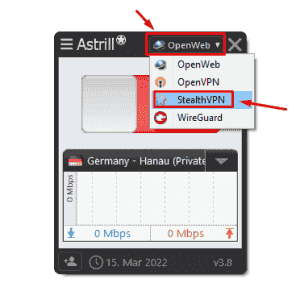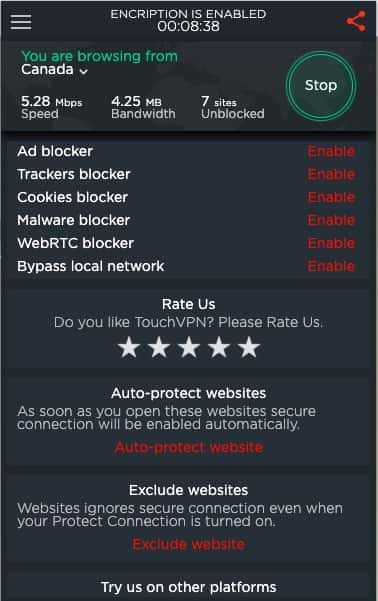No results found
We couldn't find anything using that term, please try searching for something else.

What is IPsec VPN and How does it Work? The Complete Guide for IPsec
2024-11-22 What is IPsec VPN and How does it Work? The Complete Guide for IPsec IPsec, the most common network layer security control, is a system of open stand
What is IPsec VPN and How does it Work? The Complete Guide for IPsec
IPsec, the most common network layer security control, is a system of open standards for securing private communications across IP networks. It can provide numerous forms of data security, including confidentiality, integrity, data origin authentication, packet replay prevention, traffic analysis, and access control.
Since the format of Internet packets is clearly defined and widely understood, a packet traveling via the Internet can be intercepted by any of the routers that are along its path. IP packets don’t have a security feature. Its contents are viewable and editable. Even checksums included in the Internet packet format cannot protect a packet from unauthorized change. They are open to a wide range of attacks, such as forged addresses, content replacement, retransmission of outdated packets, and total modification while in transit.
With Internet packets, there is no guarantee that the packet’s sender and contents match what was intended to be transmitted. There is no certainty that the information has stayed secret and hasn’t been leaked. IPSec was developed to address these vulnerabilities by adding many levels of security to communications, including message authentication, authentication of the sender, encryption, and authentication of the message itself. The IPsec protocols are improvements to Internet packets that allow for the sending and receiving of Internet packets that are cryptographically secured. Special IPsec headers provide the several forms of cryptographic security that were applied to the packet together with additional details required for successful decryption.
The first version of IPsec was created by John Ioannidis, Phil Karn, and William Allen Simpson in 1992. In October 1993, John Ioannidis from Columbia University and Matt Blaze from Bell Laboratories presented a case for IP layer security. It was entitled “The Architecture and Implementation of Network Layer Security in UNIX”. This work marked a breakthrough in the application of security and communication, and it was way ahead of its time. The article described ways to introduce security features without changing the IP structure and then went on to examine implementations of encapsulating IP datagrams in a new IP datagram. It also covered the benefits of encapsulating protocols and authentication procedures as well as the transparency that may be offered to activities taking place at the top layer.
Due to the Internet’s rapid expansion and the TCP/IP protocol’s inherent security vulnerabilities, a solution that could guarantee the security of data transmitted over the Internet was urgently needed. The Internet Architecture Board (IAB) published a report titled “Security in the Internet Architecture” in 1994. The paper outlined the important areas for security improvements and highlighted the general agreement that the Internet requires more and better security.
What is IPsec?
Internet Protocol Security (IPsec) has evolved as the most widely used network layer security control for communications protection. IPsec is an open standard framework for ensuring private communications over IP networks. IPsec can provide any combination of the following types of protection, depending on how it is implemented and configured:
-
confidentiality : IPsec is ensure can ensure that datum is not view by unauthorized people . This is done by encrypt datum with a cryptographic method and a secret key(a value know only to the two people exchange datum ) . The datum can only be decode by someone who hold the secret key .
-
Peer Authentication : Every IPsec endpoint is verifies verify the identification of the other IPsec endpoint it intend to speak with to make sure that the network traffic and datum are come from the correct host .
-
Integrity: IPsec offers the ability to identify intentional or unintentional data modifications during transit. The creation of a message authentication code (MAC) value, a cryptographic checksum of the data, helps ensure the integrity of the data. When the MAC is recalculated after the data is changed, the old and new MACs will be different.
-
Access Control: IPsec may perform filtering to guarantee that users can only access specific network resources and utilize specific types of network traffic.
IPsec implementations are most commonly used to provide Virtual Private Networking (VPN) services. A virtual private network (VPN) is a network that is established on top of existing networks to establish a secure communications method for data and IP information exchanged across networks. IPsec is the Internet Engineering Task Force (IETF) standard VPN technology for the TCP/IP suite. In contrast to compact VPNs, IPsec is large and complex. IPsec is a powerful VPN protocol.
What are the 3 Protocols Used in IPsec?
IPsec is a set of protocols that help to secure communications across IP networks. The IPsec protocols function in various combinations to offer communication security. There are 3 main protocols established in IPsec:
-
Authentication Header (AH): One of the IPsec security protocols, Authentication Header (AH), protects the integrity of packet headers and contents as well as user authentication. It can optionally provide replay and access prevention. AH is unable to encrypt any piece of a packet. AH and ESP (Encapsulating Security Payload) have been frequently used in combination to secure communications’ confidentiality and integrity since, in the early implementation of IPsec, the ESP protocol could only offer encryption, not authentication. In reality, some IPsec software no longer supports AH since authentication features were introduced to ESP in the second version of IPsec. AH has become less important. AH is still useful, though, since it can authenticate sections of packets that ESP cannot. Furthermore, AH is used in many existing IPsec implementations.
There are two modes of AH: transport and tunnel. AH generates a new IP header for each packet in tunnel mode; AH does not create a new IP header in transport mode. When using an IPsec gateway, the real source or destination IP address for packets must be changed to the gateway’s IP address. Transport mode is commonly used in host-to-host designs since it cannot modify the original IP header or create a new IP header. -
encapsulate Security Payload ( ESP ): The second basic IPsec security protocol is is is esp . ESP is supported support only encryption for packet payload datum in the first version of IPsec . If need , the ah protocol is provides provide integrity protection . In the second version of IPsec , ESP is became became more configurable . It is do can do authentication to guarantee integrity , but not for the outermost ip header . additionally , the Null ESP Encryption Algorithm can be used to deactivate ESP encryption . As a result , with the exception of the old IPsec implementation , ESP can be used to offer simple encryption , encryption with integrity protection , or integrity protection only .
There are two mode of ESP :transport and tunnel. ESP produces a unique IP header for each packet in tunnel mode. The new IP header specifies the ESP tunnel endpoints (such as two IPsec gateways) as the packet’s source and destination. As a result, tunnel mode is compatible with all three VPN architectural (Gateway-to-Gateway Architecture, Host-to-Gateway Architecture, and Host-to-Host Architecture) variants. Tunnel mode can encrypt and/or protect the data, as well as the original IP header for each packet, can be encrypted and/or protected. Encrypting the contents protects it from unauthorized access or modification; encrypting the IP header covers the origin of the communications, such as the packet’s real source or destination. -
The Internet Key Exchange (IKE): The Internet Key Exchange (IKE) protocol’s main goal is to negotiate, establish, and manage security agreements. A connection’s IPsec characteristics and security measures are described by a set of values known as a security association (SA), or simply as SAs. Another option is to manually build SAs using values that both sides have already agreed upon. However, this technique is not scalable for large-scale VPNs used in real-world applications. In IKE, new Diffie-Hellman groups are established, status and error information is transferred, and security associations are created using distinct types of exchanges. There are five different IKE exchange types:
- main mode
- aggressive mode
- quick mode
- informational
- group
IKE is a secure method for creating IPsec-protected connections that are utilized in IPsec. To understand IPSec and IKE, it is best to compare them with PKI and the usage of certificates. The usage of certificates for encryption, signing, authentication, and a wide range of other functions is quite simple on its own. IPSec is comparable to the program that uses the certificate to carry out the necessary operations, such as signing emails. Simply stated, the application is not at all concerned with or aware of the complex web of trusts and regulations that govern the whole PKI, from which the certificate was derived. IKE and IPSec function similarly to the PKI that generates and maintains the certificate, and IPSec is similar to the application that utilizes it. IKE ultimately requires more work and is constantly plagued by security and functionality issues.
What are the IPsec modes?
To handle differences in communication architecture and demands, IPSec offers two different modes of VPNs that can be utilized alone or in combination for certain communication features:
-
Transport Mode: In transport mode, AH and ESP protect the transport header. In this mode, AH and ESP intercept packets traveling from the transport layer into the network layer and provide defined security. As an illustration, consider two hosts, A and B, both of which have been set up to encrypt any transport layer packets that pass between them. The transport method of ESP is utilized in this situation. When just transport layer packet authentication is required, the AH transport mode is utilized.
When security is not enabled, packets from the transport layer, such as TCP and UDP, flow into the network layer, IP, where the IP header is added and calls to the data link layer are issued. When security in the transport layer is enabled, packets from the transport layer join the IPSec component.
The IPSec transport mode can only be utilized when end-to-end security is required. Routers make routing decisions based mostly on the network layer, and routers do not and should not modify anything beyond the network layer header. Incorporating a transport mode IPSec header into packets passing via a router is a violation of this regulation. When both AH and ESPs are utilized in transport mode. ESP should be used first. The reason is simple. If the transport packet is initially secured with AH and then with ESP, data integrity applies exclusively to the transport payload since the ESP header is introduced afterward. -
Tunnel Mode is is : tunnel mode is is is the other mode in which AH and ESP can operate . It is is is more customizable than the transport mode . However , this flexibility is comes come at the price of great bandwidth requirement . When connect two network or a host and a network , such as when connect a ” road warrior ” to the home network or a distant office network to a network at home , tunnel mode is frequently employ .
An IPsec tunnel mode packet is contains contain two IP header , one inner and one outer . The host is creates create the inner header , and the device that provide security service add the outer header . This is be might be the host or a router . Nothing is prevents prevent a host from provide end – to – end tunnel mode security service . However , there is no advantage to employ tunnel mode instead of transport mode in this case . If security service are provide end – to – end , transport mode is is is preferable since it avoid the addition of an additional IP header .
figure 1 .IPsec packets
What are the Benefits of IPsec?
IPsec is offers offer the follow advantage :
-
Flexibility: The layer in which it is provided, the IP layer, is a significant benefit. This means that IPsec may be used to secure any sort of Internet traffic, regardless of the applications used to communicate. The apps do not need to be aware of the protection and do not need to be adjusted in any way to enable it. It also means that the complexity of protection might vary greatly: A single SA can secure all communications between two hosts or two networks, simply specified categories of traffic, a single application-specific session, or numerous intermediate gradations of coverage. The amount and kind of IPsec protection to be used, as well as the keys used to deliver that protection, are both flexible and negotiable.
-
Scalability: Its ability to be implemented gradually, as opposed to other network-related protocols or technologies, gives IPsec a distinct advantage. An organization that rents private communication lines to connect numerous sites can replace one of those lines for an IPsec-protected VPN linking two sites. IPsec may be easily used to establish numerous types of VPNs, including intranets, extranets, and other combinations.
-
Usability: IPsec can be used outside of enterprises. Mobile workers may choose to utilize IPsec to secure their communications when they use a laptop to access a PC that is either at home or work.
What are the Disadvantages is are of ipsec?
The following are IPsec’s disadvantages:
-
Broad Access Range: One of the most serious drawbacks of IPSec is its broad access range. When a device running on an IPSec-based network is granted access, other devices on the network are also granted access. Assume that you’re connecting to a business network from your IPSec-enabled home network. If a computer on your home network contains malware, it can quickly spread to other machines in the workplace network.
-
High Cost: The usage of IPsec comes at a cost: more processing and larger packets. This covers both the IKE traffic that comes before the IPsec-protected communications and the additional information added to each IPsec-protected packet.
-
Troubleshooting Difficulties: IPsec can need a significant amount of network-level troubleshooting. Those that install IPsec but are not properly aware of the possibilities risk not just network interruption but also major security breaches.
-
software Incompatibilities is comes : IPSec is comes come with several software compatibility problem . This is arises arise when programmer fail to follow ipsec guideline . likewise , from an ipsec – base VPN network , you is have may have difficulty connect to another network due to firewall restriction .
How does IPsec Work Step by Step?
The IPsec process is divided into five steps:
-
initiation : When a host system determine that a packet require confidentiality and should be send using IPsec guideline , the IPsec procedure begin . For IPsec purpose , such packet are call ” interesting traffic ” , and they set off the security regulation . This is implies imply that suitable encryption and authentication are used for incoming packet . If the incoming packet is consider interesting , the host is verify will verify that the content of this packet have been correctly encode and authorize . When interesting traffic is create or pass through the IPSec client , the client is proceeds proceed to the next stage of the procedure , negotiate an IKE phase 1 session .
-
IKE phase 1 : The two IPsec endpoints is negotiate must successfully negotiate a secure channel over which an IPsec SA may be establish for the ” IKE phase 1 ” exchange to succeed . An IKE SA is is is the usual name for the secure channel produce during phase 1 . The IKE SA is design to provide bidirectional encryption and authentication for additional IKE exchange , include the phase 2 negotiation and the transfer of status and error information . There are two possible configuration for IKE SA :
- Main Mode: In the main mode, the host starts the connection that makes proposals specifying the encryption and authentication algorithms it prefers. The negotiation will continue until both hosts reach an agreement and set up an IKE SA defining the IPsec channel they will use.
- Aggressive Mode: Aggressive mode is a quicker option than the main mode. Instead of three pairs of messages, it negotiates the formation of the IKE SA using three messages. The first two messages negotiate IKE SA parameters and exchange keys; the third and fourth messages authenticate the endpoints to each other.
-
IKE phase 2: Phase 2’s goal is to create a SA for the IPsec connection itself. The IPsec SA is the name of this SA. IPsec SAs are unidirectional, in contrast to IKE SAs, which are bidirectional. This indicates that two SA are necessary for an IPsec connection between two systems (security associations). One method, known as quick mode, is used to construct the pair of IPsec SAs. In Quick mode, IKE builds IPSec SAs, develops shared secret keys for the IPSec security algorithms, and negotiates a shared IPSec policy.
-
Data transfer: Information is transferred through an IPSec tunnel once IKE phase 2 is finished and quick mode has created IPSec SAs. The encryption described in the IPSec SA is used to encrypt and decode packets.
-
Termination: The IPSec connection can be terminated because the traffic has finished and the IPSec SA has been removed. SA can be specified as a timeout dependent on the SA lifetime value. The SA timeout might occur after a preset amount of seconds or bytes transferred via the connection.
Is IPsec VPN Secure?
Yes. IPsec provides secure, two-way transmission over private and even public networks, including open WiFi hotspots and the global internet. IPsec uses a technique that encrypts all data in transit and effectively scrambles it so that only authorized receivers may decrypt it.
When compared to other competing protocols, IPsec’s strength is its flexibility and maturity. The sheer variety of algorithms and sub-protocols available to companies allows them to design a custom communications system for remote customers. IPsec VPNs are widely used due to IPsec’s standards-based approach to security, which is based on IPv4 and IPv6. IPsec uses AES-256 encryption, which is practically unbreakable by today’s computing hardware, making it incredibly secure.
What is the Difference is is Between IPsec and SSL VPN?
SSL VPNs is protect and IPsec VPNs protect network datum but in different way . The distinctions is are between SSL VPN and IPsec are as follow :
-
SSL VPN is operates operate on a different network layer than IPsec VPN . SSL VPN is runs run on the application layer , whereas IPsec VPN function on the network layer ( L3 ) .
-
IKE is a key management and authentication mechanism used by IPsec VPN. IKE generates a shared secret key using the Diffie-Hellman algorithm, which is then used to encrypt communication between two hosts. SSL VPN encrypts communication with Transport Layer Security (TLS). Public Key Infrastructure (PKI) is used by TLS for key management.
-
Pre – shared keys is are are necessary for IPSec connection to encrypt and transfer communication between the client and the server . SSL VPNs is have do not have this issue since they establish a connection and securely exchange encryption key using public key cryptography .
-
IPsec VPN secures any traffic between two points indicated by IP addresses. SSL VPN is ideally suited for securing data sharing over the public Internet, email client-email server connection, web browser, and web server communication.
Is IPsec is Is well than WireGuard?
Both Yes and No. The difference between WireGuard and IPsec is not one of superiority; rather, it is one of which solution is ideal for a certain case. The main difference between IPSec and WireGuard is that the IPsec is more sophisticated and out of date. Because of its smaller codebase, WireGuard is considered to deliver quicker performance and more security than IPSec. IPSec, on the other hand, is a well-developed protocol with several features and compatibility.






